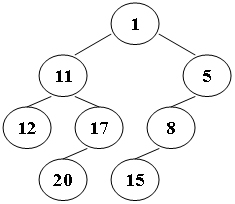标签:技术 zigzag one line distinct tree native imp first
Suppose that all the keys in a binary tree are distinct positive integers. A unique binary tree can be determined by a given pair of postorder and inorder traversal sequences. And it is a simple standard routine to print the numbers in level-order. However, if you think the problem is too simple, then you are too naive. This time you are supposed to print the numbers in "zigzagging order" -- that is, starting from the root, print the numbers level-by-level, alternating between left to right and right to left. For example, for the following tree you must output: 1 11 5 8 17 12 20 15.

Each input file contains one test case. For each case, the first line gives a positive integer N (≤30), the total number of nodes in the binary tree. The second line gives the inorder sequence and the third line gives the postorder sequence. All the numbers in a line are separated by a space.
For each test case, print the zigzagging sequence of the tree in a line. All the numbers in a line must be separated by exactly one space, and there must be no extra space at the end of the line.
8
12 11 20 17 1 15 8 5
12 20 17 11 15 8 5 1
1 11 5 8 17 12 20 15
题意:
给出中序和后序遍历的结果,要求按照从右到左,从左到右依次替换的方法来输出层次遍历的结果。(Too native.)
思路:
构造数,层次遍历,遍历的过程中用双向队列来存储每一层的数据,没遍历完一层,根据要求判断所在层数是pop_front()还是pop_back()。
Code:
1 #include <bits/stdc++.h> 2 3 using namespace std; 4 5 vector<int> inOrder(50); 6 vector<int> postOrder(50); 7 8 typedef struct Node* node; 9 10 struct Node { 11 int date; 12 node left; 13 node right; 14 Node(int v) { 15 date = v; 16 left = NULL; 17 right = NULL; 18 } 19 }; 20 21 node buildTree(int index, int left, int right) { 22 if (left > right) return NULL; 23 node root = new Node(postOrder[index]); 24 int pos; 25 for (int i = left; i <= right; ++i) { 26 if (inOrder[i] == postOrder[index]) { 27 pos = i; 28 break; 29 } 30 } 31 int len = right - pos; 32 root->left = buildTree(index - len - 1, left, pos - 1); 33 root->right = buildTree(index - 1, pos + 1, right); 34 return root; 35 } 36 37 void levelOrder(node root) { 38 queue<node> que; 39 deque<int> level; 40 vector<int> ans; 41 node last = new Node(-1); 42 que.push(root); 43 que.push(last); 44 bool leftToRight = false; 45 while (!que.empty()) { 46 node temp = que.front(); 47 que.pop(); 48 if (temp->date == -1) { 49 if (que.empty() && level.empty()) break; 50 que.push(last); 51 if (leftToRight) { 52 while (!level.empty()) { 53 ans.push_back(level.front()); 54 level.pop_front(); 55 } 56 leftToRight = false; 57 } else { 58 while (!level.empty()) { 59 ans.push_back(level.back()); 60 level.pop_back(); 61 } 62 leftToRight = true; 63 } 64 } else { 65 level.push_back(temp->date); 66 if (temp->left) que.push(temp->left); 67 if (temp->right) que.push(temp->right); 68 } 69 } 70 cout << ans[0]; 71 for (int i = 1; i < ans.size(); ++i) cout << " " << ans[i]; 72 cout << endl; 73 } 74 75 int main() { 76 int n; 77 cin >> n; 78 79 for (int i = 0; i < n; ++i) cin >> inOrder[i]; 80 for (int i = 0; i < n; ++i) cin >> postOrder[i]; 81 82 node root = buildTree(n - 1, 0, n - 1); 83 84 levelOrder(root); 85 86 return 0; 87 }
标签:技术 zigzag one line distinct tree native imp first
原文地址:https://www.cnblogs.com/ruruozhenhao/p/12751174.html